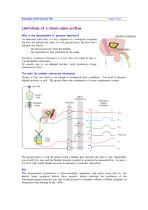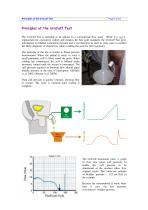
Catalog excerpts

Principles of the UroCuff Test Principles of the UroCuff™ Test Adopted from Dr. Michael Drinnan & Dr. Clive Griffiths Newcastle University
Open the catalog to page 1
Principles of the UroCuff Test
Open the catalog to page 2
Principles of the UroCuff Test Basic urology - the flow measurement The single most obvious and objective symptom of most men's urodynamic complaints is a hesitant flow or a poor flow rate, and so the most basic tool of the in-office prostate assessment is the flow meter, or uroflow. Th e U roCu ff in strumen t h ad a pro toco l o p tion for stand alon e u ro flo w. Measurement of flow rate and voided volume A flow meter provides measurements of flow rate (Q) and voided volume (Vvoid). Vvoid is usually measured in milliliters (ml), while Q is measured in milliliters per second (ml/s). Flow...
Open the catalog to page 3
Principles of the UroCuff Test Limitations of a stand-alone uroflow Why is the measurement of pressure important? An abnormal urine flow is a key symptom of a urological complaint, but does not indicate the cause. In very general terms, the flow rate is affected two factors: The driving pressure from the bladder; The opposition to flow presented by the outlet. Therefore, symptoms of hesitancy or a poor flow rate might be due to: a weak bladder contraction. Or equally, due to: an enlarged prostate (right) producing a large obstruction to flow. The need for bladder contraction information...
Open the catalog to page 4
Principles of the UroCuff Test Principles of the UroCuff Test The UroCuff Test is intended as an adjunct to a conventional flow study. While it is not a replacement for cystometry (which still remains the best gold standard), the UroCuff Test gives information on bladder contraction pressure and it can therefore be used in some cases to confirm the likely diagnosis of obstruction, while avoiding the need for full cystometry. The principle of the test is similar to blood pressure measurement. When the patient is ready to void, a small pneumatic cuff is fitted round the penis. When voiding...
Open the catalog to page 5
Principles of the UroCuff Test Principles underlying the UroCuff Test To work properly, the Urocuff Test depends on three key principles: Inflation pressure in the penile cuff is transmitted to the penile urethra 250 Purethra (cm H20) First, pressure in the cuff must be transmitted to the penile urethra so that when cuff pressure exceeds the fluid pressure, flow stops. To this end, we have made simultaneous measurements of cuff and urethral pressure for a range of cuff materials and sizes (Drinnan et al, 2001a). The figure shows this relationship for the two cuff widths finally used - 38mm...
Open the catalog to page 6
Principles of the UroCuff Test The UroCuff instrument printout The UroCuff instrument produces a printout like the one shown below. In the top half of the page are the original cuff pressure (green), flow rate (orange) and voided volume (magenta) signals. The shaded grey areas correspond to periods when the cuff was actively inflating, as can be judged from the rising cuff pressure. Beneath are the four graphs of flow versus cuff pressure, corresponding to the four shaded areas of cuff inflation. From these graphs can be estimated the bladder pressure at the point of flow interruption....
Open the catalog to page 7
Principles of the UroCuff Test Estimation of cuff interruption pressure For interpretation of the measurements, the UroCuff instrument extrapolates the downward slope of the flow versus Cuff pressure graph, and estimate where it would reach zero flow. This example shows four cuff measurements where it is relatively easy to estimate the interruption pressure. In each case, the red line shows our 'best fit' to the downward slope. NON-INVASIVE BLADDER TEST We would automatically accept these four inflations and make estimates of 160, 160, 120 and 115 cm H2O respectively for interruption...
Open the catalog to page 8
Principles of the UroCuff Test Exclusion rules In the example, all the cuff inflation cycles are easy to interpret. In other cases, w e d o n o t automatically accept the inflation and estimate interruption pressure. An inflation cycle should be excluded immediately if: (1) There was no recovery of flow after cuff deflation When the cuff is released after an inflation cycle, one normally expects a brief surge of urine stored in the proximal urethra, followed by the resumption of flow. This is seen clearly in the printout on the previous page. If there is no flow recovery, this indicates...
Open the catalog to page 9
Principles of the UroCuff Test Validation studies Agreement of cuff interruption pressure with true bladder pressure The results are shown in the figure; on average, pcuff,int over-estimated pves,isv by 16.4 ± 27.5 cm H2O, and possible reasons for the discrepancy are discussed later. As w e h a v e s a i d , the cuff interruption pressure should give an estimate of the simultaneous value of isovolumetric bladder pressure. In 153 patients we performed the cuff measurement with simultaneous invasive cystometry (McIntosh et al, 2003). For each cuff inflation cycle we estimated the cuff...
Open the catalog to page 10
Principles of the UroCuff Test Abdominal pressure and straining One of the key features of cystometry is the provision of a rectal line, for measurement of abdominal pressure. Since the UroCuff Test is non-invasive, it does not provide any measurement of abdominal pressure, and we have considered the potential implications. The origin of abdominal pressure The resting pressure in the abdomen is caused by the weight of body tissues sitting within the abdomen. Since the lungs and diaphragm must be at (approximately) atmospheric (zero) pressure, and the body is largely water, you might...
Open the catalog to page 11
Principles of the UroCuff Test Bladder contractility and isovolumetric pressure As we have already said, the UroCuff Test estimates isovolumetric pressure. The isovolumetric pressure is the pressure in the bladder when flow is completely stopped, and is therefore an indicator of bladder contractility under known 100 conditions Pabd (cm H2 O) The figure shows invasive data recorded during a UroCuff Test. As the cuff is inflated (green trace), the flow is reduced and finally stops (orange trace). At this point, the isovolumetric detrusor pressure can be read from pdet (purple trace)....
Open the catalog to page 12All SRS Medical catalogs and technical brochures
-
urocuff test
1 Pages
-
uroCuff
2 Pages
-
the spanner
16 Pages
-
EasyFlo?
2 Pages
Archived catalogs
-
Aware PFS Brochure
2 Pages
-
Aware EMG Brochure
2 Pages
-
CT3000plus?
2 Pages
-
uroScan® Bladder Ultrasound
2 Pages
-
EASYPRO?4
2 Pages










